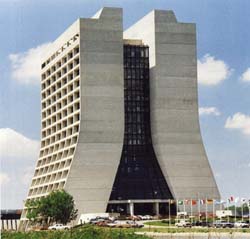Fermilab: Its Role in Proton Therapy Development in the U.S.
Robert Wilson founded Fermilab and led it through its first decade. He maintained his long-standing interest in proton therapy, and in the early 1970's, he and some of his colleagues proposed to use the Fermilab linear accelerator for therapy when it was not in use as an injector. But, the ability to make use of the localized dose of protons depends on knowing the location of the tumor. The technology to perform this localization was not fully developed at that time, and the physicians collaborating with Fermilab urged them to produce neutrons with the proton beam and to perform therapy with neutrons. Neutrons are somewhat more efficient than protons or electrons at killing cells, but do not have the great advantages of protons in localizing the dose. The Fermilab Neutron Therapy Facility has been in operation for more than ten years and has treated more than 1,600 patients.
In the intervening years, proton therapy has proceeded at Harvard, and CAT scanning and MRl have come to fruition. With their use, it is possible to take full advantage of the tight control of the irradiated site that is possible with protons. It is now advantageous to build an accelerator and facility specifically for the treatment of disease with proton beams in a hospital setting.
In January 1985, a group interested in studying the design of potential proton accelerators, facilities, and clinical trials met at Fermilab in Batavia, Illinois for the first in a series of meetings. In these meetings, the group, which came to call itself the Proton Therapy Cooperative Group (PTCOG), proposed and discussed a variety of machine designs and beamdelivery systems. One outgrowth of the PTCOG meetings has been an agreement between Loma Linda University and Fermilab, whereby Fermilab will design and fabricate a 70 to 250 MeV proton synchrotron and assist in the design and procurement of a beam transport and delivery system for installation at Loma Linda University Medical Center.
Fermilab is owned by the United States Department of Energy and operated by Universities Research Association, Inc.






